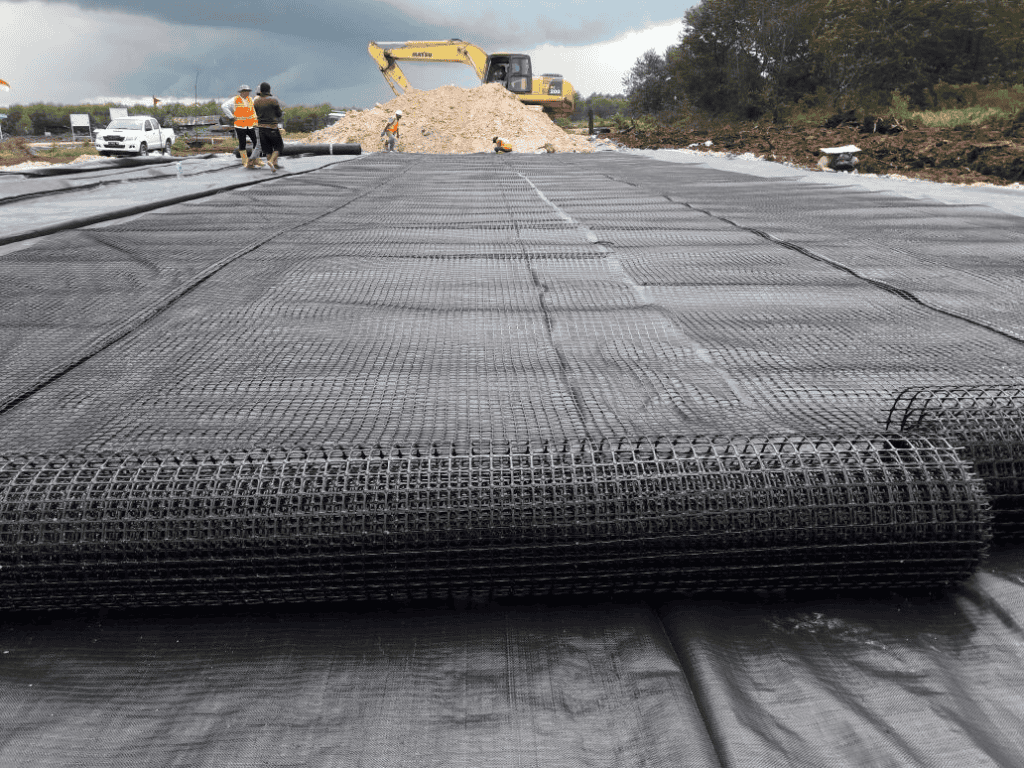Biaxial geogrid is a high-strength mesh structure material made of polypropylene (PP) through a special process. It is characterized by “two-dimensional” tensile properties, that is, the grid has uniform strength in both directions, which enables it to better disperse and transfer external loads, especially playing an excellent reinforcement role on soft foundations and weak soil layers. Compared with traditional geosynthetics (such as geotextiles, geomembranes, etc.), PP biaxial geogrid has more advantages in load distribution and tensile properties, and is especially suitable for special engineering environments such as heavy-load transportation and soft soil foundations.

Features of PP Biaxial geogrid
- Bidirectional tensile performance: Unlike unidirectional geogrids, PP bidirectional geogrids can provide tensile force evenly in two directions, thereby effectively improving the reinforcement effect and enhancing the stability of the soil.
- High strength and compressive resistance: PP biaxial geogrid can withstand heavy loads and are particularly suitable for road or railway construction projects with heavy traffic loads.
- Durability and anti-aging: Polypropylene materials have excellent weather resistance and can maintain stable physical properties for a long time under high temperature, low temperature, humidity and other environments. They are particularly suitable for use in harsh climatic conditions.
- Save materials and costs: Compared with traditional civil engineering reinforcement methods, PP bidirectional geogrids use less materials while providing the same strength, reducing construction and material costs.
- Convenient construction: The installation process of PP bidirectional geogrids is simple and quick, which can greatly shorten the construction period.
PP Biaxial geogrid pavement application
- Roadbed reinforcement and stabilization; soft soil foundation and uneven settlement are often the key factors affecting the stability of the road. PP biaxial geogrid can effectively disperse traffic loads by embedding in the soil layer, reduce the longitudinal deformation and lateral displacement of the soil, and thus improve the overall stability of the roadbed. The bidirectional tensile property of the grid can make the load evenly distributed and avoid cracks or deformation of the road surface caused by uneven settlement.
- Road surface layer reinforcement; the role of PP bidirectional geogrid is not limited to strengthening the roadbed, but also can significantly improve the crack resistance and durability of the road surface layer. In the case of multi-lane or heavy-load traffic, the road surface bears a large load. The application of PP bidirectional geogrid can effectively enhance the road surface’s resistance to external forces and prevent cracks, settlement and other road surface diseases.
- Prevent soil and water loss and resist erosion; PP biaxial geogrid can effectively prevent soil and water loss in addition to strengthening the soil. In areas such as slopes, bridges and protective walls, the grid can limit soil loss and avoid rainwater erosion on the soil. This feature is particularly important in some special environments (such as mountainous areas and coastal areas).
- PP biaxial geogrid is widely used in highways and urban roads. It can effectively enhance the bearing capacity of the roadbed, prevent road surface settlement caused by traffic loads, seasonal changes, etc., and ensure the safety and stability of the road. Especially in soft soil areas, PP bidirectional geogrid has become an ideal reinforcement material.

Technical advantages of PP bidirectional geogrid
- Improve road bearing capacity; By burying PP biaxial geogrid in the road base, the bearing capacity of the road can be significantly improved, avoiding the adverse effects of soft soil foundation and uneven settlement on the road surface. Especially on roads with frequent heavy traffic, the application of grids can improve the overall bearing performance of the road.
- Enhance the stability of the soil; The bidirectional tensile structure of PP biaxial geogrid can effectively enhance the stability of the soil and prevent excessive settlement or displacement of the soil due to external loads or changes in natural conditions. Its application can reduce uneven settlement during construction and ensure the flatness and structural stability of the road surface.
- Environmental adaptability and durability; PP material has excellent chemical resistance, corrosion resistance, and UV resistance, and can maintain good stability under different environmental conditions. In areas with large temperature differences and high humidity, PP bidirectional geogrid can still maintain its structural performance, strong adaptability, and long service life.
Case Analysis
International Case: Road Construction in Brazil; In the road construction project in Rio de Janeiro, Brazil, due to the complex geological conditions in the area, the project owner chose PP biaxial geogrid to reinforce the foundation pit and soil layer. After application, the road construction went smoothly, avoiding the risk of groundwater infiltration and soil loosening.

Conclusion
As a new type of pavement reinforcement material, PP biaxial geogrid plays an important role in modern road construction with its bidirectional tensile properties, strong compressive resistance, durability and economy. PP biaxial geogrid will play a more important role in future road construction, reinforcement and maintenance. By improving the stability and bearing capacity of roads, it will become one of the core technologies to promote the high-quality development of road construction. If you have any questions about PP biaxial geogrid or need more information, please feel free to contact us. We will provide personalized product recommendations and professional technical support based on your project needs to ensure the smooth progress of your project.






